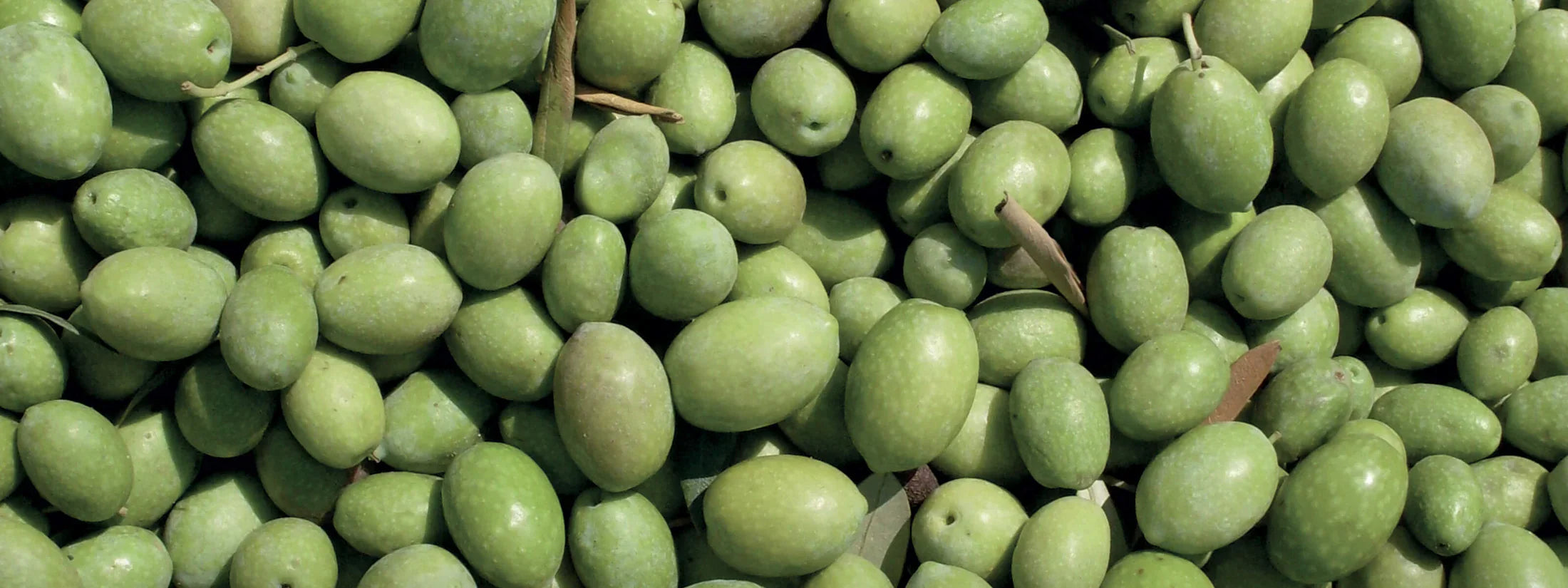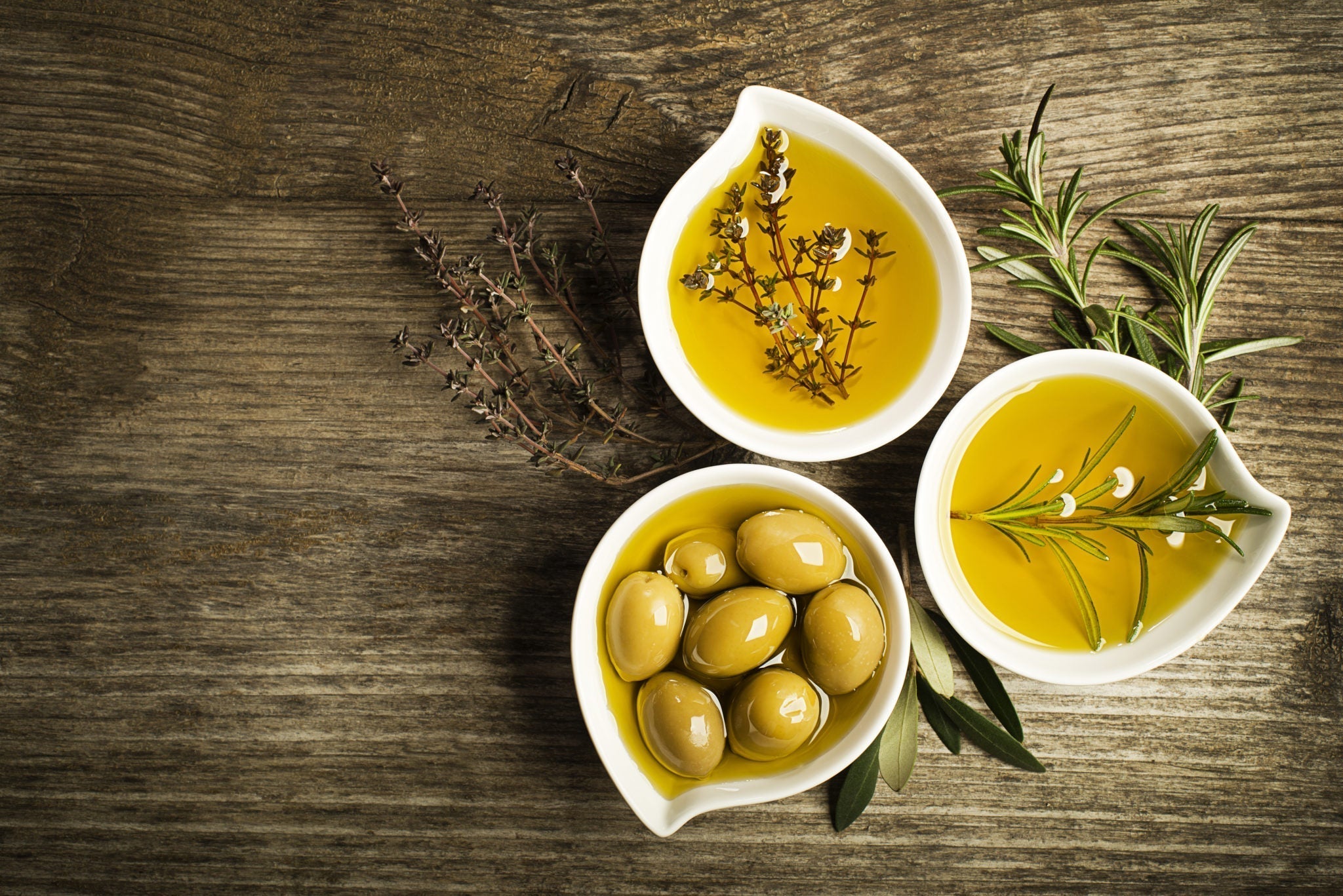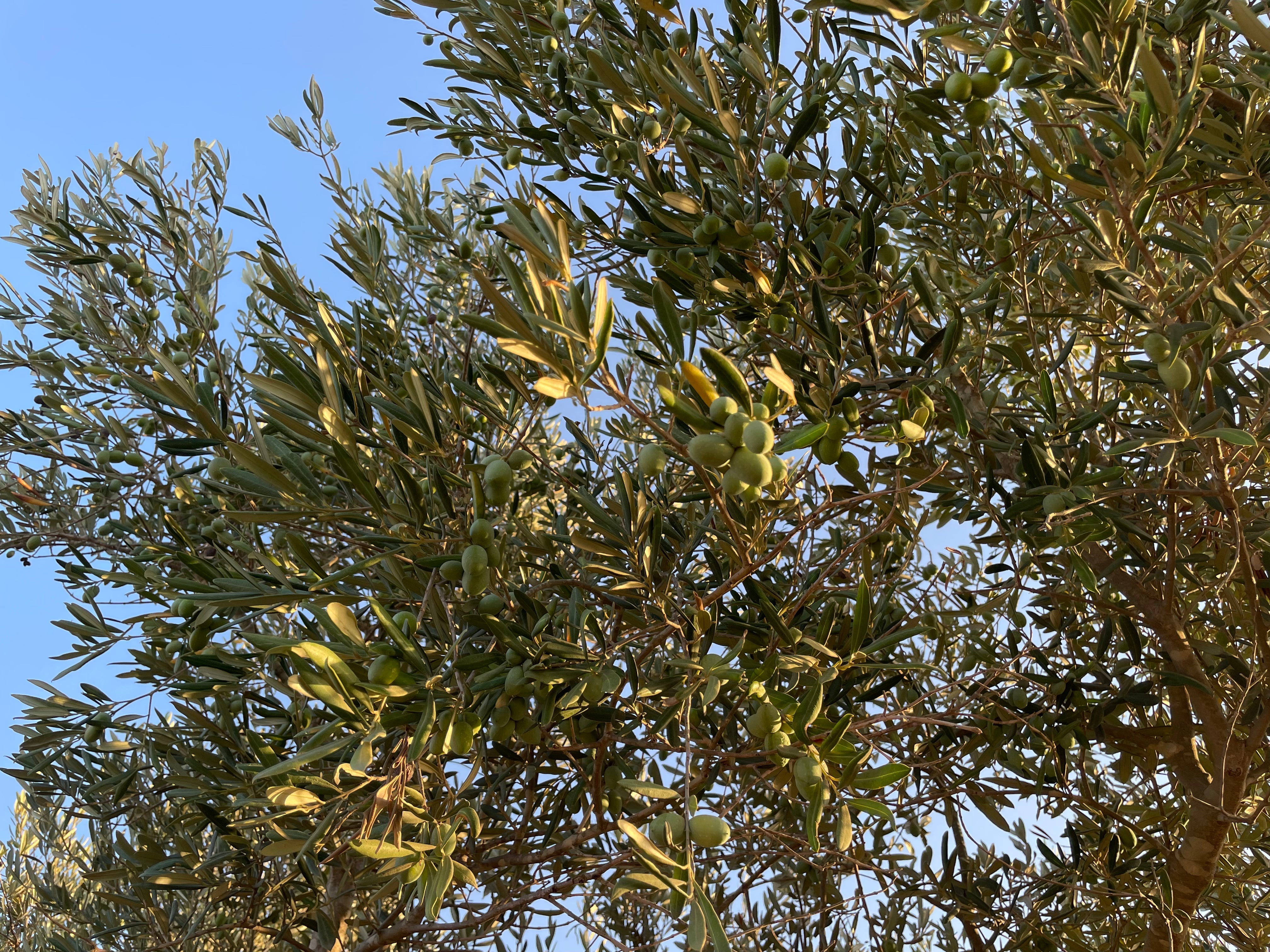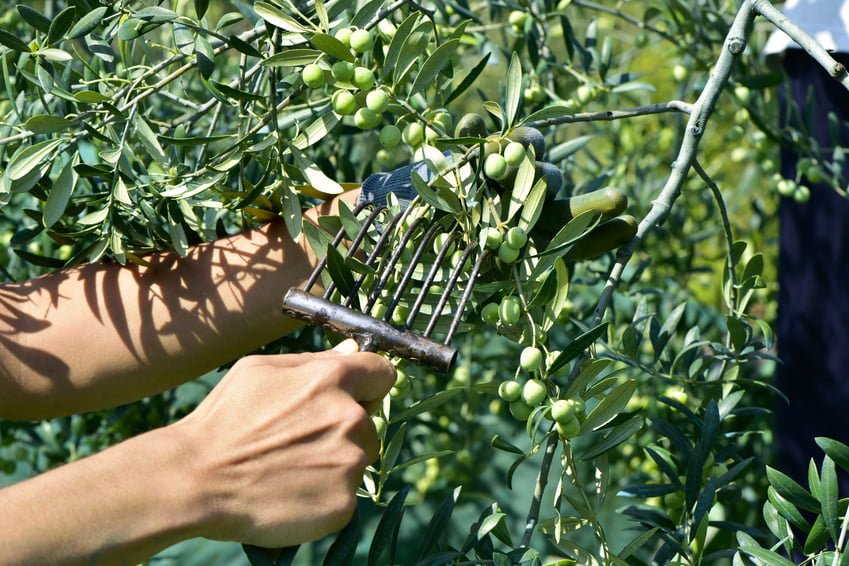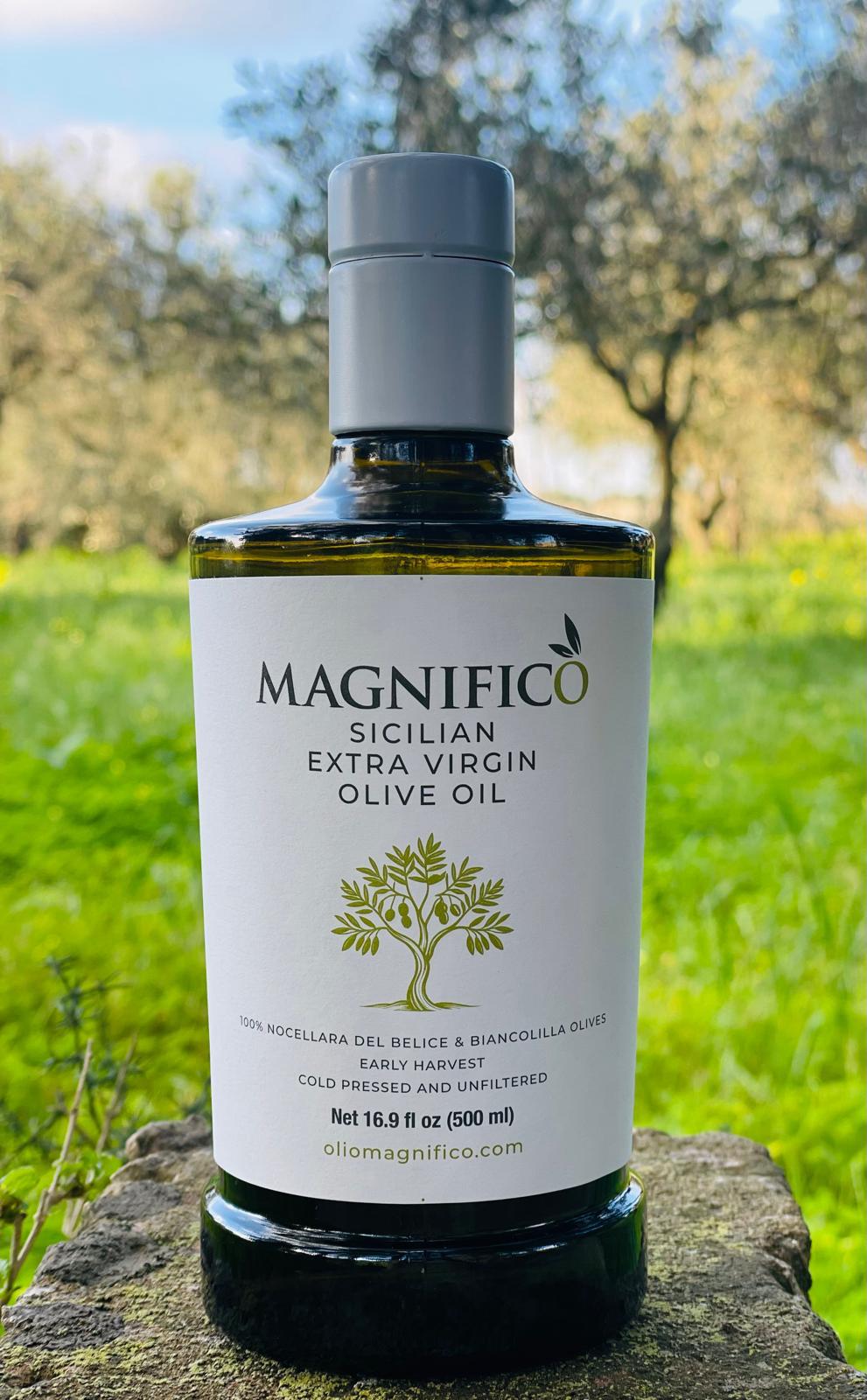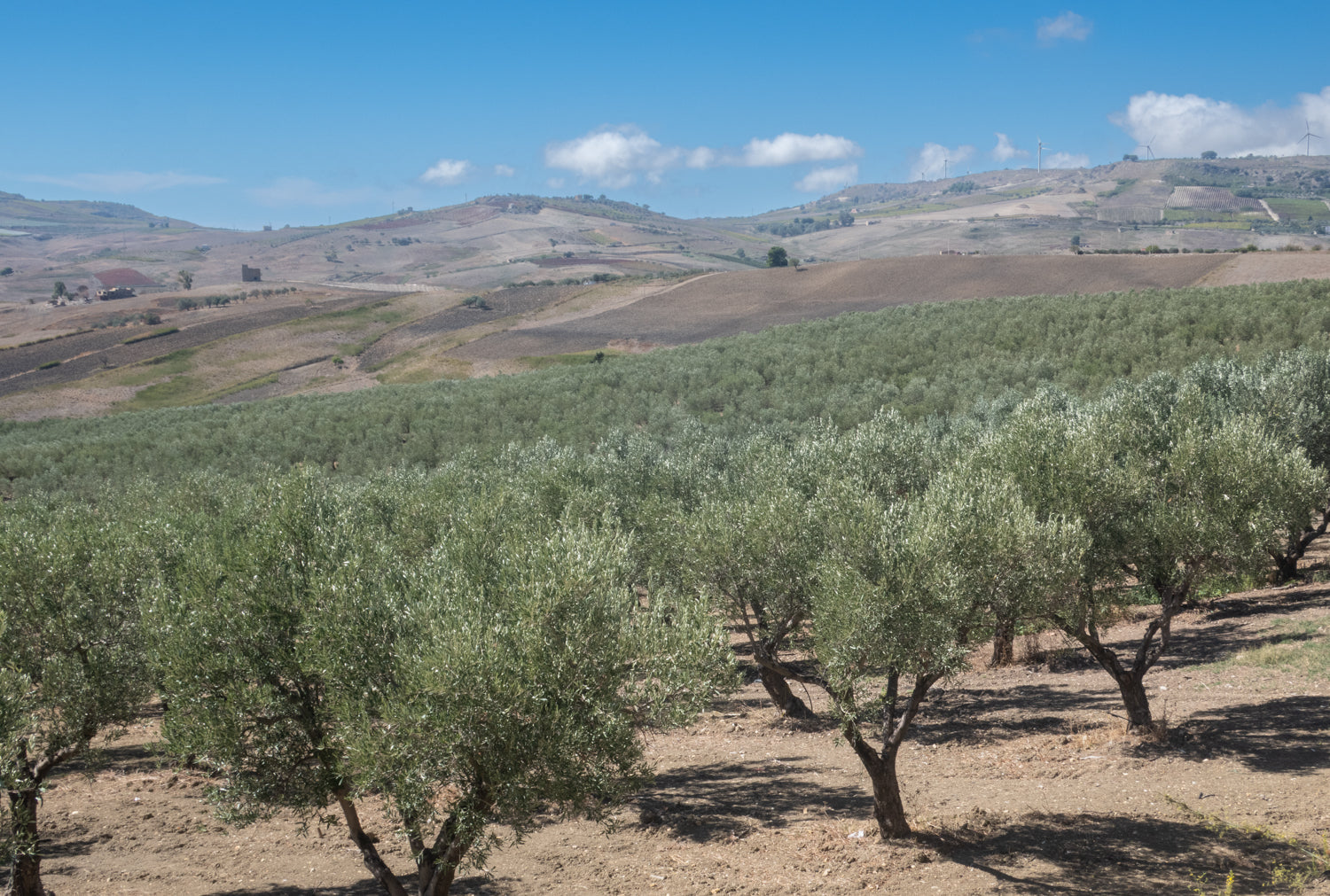
Cold-Pressed and Unfiltered: Exploring Olio Magnifico’s Nocellara & Biancolilla Olive Oils
Extra virgin olive oil is more than a kitchen staple – it’s a pillar of Mediterranean culture and renowned for its flavor and health benefits. But not all olive oils are created equal. Terms like “cold-pressed” and “unfiltered” signal an oil that’s been crafted with utmost care to preserve its quality. At Olio Magnifico, these aren’t just buzzwords; they reflect our traditional process and the character of the olives we use. In this post, we’ll demystify what cold-pressed, unfiltered olive oil means, explain why these methods matter, and spotlight two prized Sicilian olive cultivars – Nocellara del Belice and Biancolilla – known for producing exceptional oils. From the milling process to the sensory profiles and science-backed health perks of these oils, here’s everything a food-savvy shopper might want to know.
The Art of Cold-Pressing Olive Oil
Making high-quality extra virgin olive oil starts with a cold-press process – a traditional, mechanical method of extraction that uses no added heat. Olives are picked at their peak, then crushed into a paste and pressed or spun (in modern centrifuges) to release their golden-green oil. The key is temperature control: by keeping the olive paste below about 27°C (80°F) during extraction, producers ensure the oil remains “cold-pressed”mecenemarket.com. This gentle approach helps preserve the olive’s natural flavors and nutrients. In contrast, industrial oils often use heat or solvents to extract more oil, which yields a higher volume but at the cost of flavor and healthy compounds.
Cold-pressing is distinct because it avoids the high-heat refining that “pure” or “light” olive oils undergo. When olive oil is pressed without heat or chemicals, more of the olive’s original components make it into the bottle mecenemarket.com. That means cold-pressed extra virgin oils retain higher levels of antioxidants, vitamins, and aromatic flavor compounds than refined oils. For example, cold processing conserves delicate polyphenols (natural antioxidant compounds) and vitamin E that would be damaged by high temperatures mecenemarket.com. These substances not only contribute to the oil’s taste and shelf stability, but also to its nutritional value. In short, cold-pressed oil is prized for being as close to “juice of the olive” as you can get, with minimal alteration from tree to bottle.
Another big benefit of true cold-pressing is seen in the health profile of the oil. Extra virgin olive oil is about 70–80% oleic acid, a heart-healthy monounsaturated fat that withstands the gentle extraction process oliomagnifico.com. Cold-pressed oils keep this fat intact along with dozens of minor compounds like oleuropein, hydroxytyrosol, and other polyphenols. Research shows that using lower temperatures preserves these polyphenols – high heat can destroy them, so starting with cold extraction is crucial for a polyphenol-rich oil allrecipes.com. For consumers, that means a robust extra virgin olive oil will deliver both superior taste and a higher antioxidant content.
What Does “Unfiltered” Olive Oil Mean?
Freshly pressed, unfiltered olive oil has a cloudy, vibrant green appearance. Over time, as tiny olive particles settle, the oil naturally clarifies.
When olive oil is newly pressed, it often appears cloudy or opaque – this is unfiltered olive oil, sometimes called olio nuovo (“new oil”). Unfiltered oil contains microscopic bits of olive flesh and a bit of olive juice (water) that remain suspended in the liquid as a byproduct of the milling process oliveoil.com. Rather than filtering these particles out, the oil is bottled in its raw form. The result is an attractive, rustic look: a thick, greenish oil that may even leave a sediment at the bottom of the bottle over time.
But unfiltered olive oil isn’t just about appearance; many connoisseurs seek it out for the flavor and potential nutritional perks. Immediately after production, an unfiltered extra virgin oil can taste particularly lush and “full,” with bold fruity and peppery notes. Some tasters feel those remaining olive solids give the oil a richer aroma and flavor intensity oliveoil.com. There’s an appealing freshness to it – imagine the aroma of an olive mill captured in a bottle. However, this difference in taste compared to filtered oil may be short-lived. As the oil settles in the weeks or months after pressing, much of the sediment drops out and any initial flavor advantage can mellow. In fact, experts note that after a couple of months, a well-made filtered oil might actually taste fruitier than an unfiltered one, because filtering helps stabilize the delicate flavors long-term oliveoil.com.
From a nutritional standpoint, the debate about filtered vs. unfiltered is interesting. Those tiny bits of olive and moisture in unfiltered oil mean it carries both water-soluble and fat-soluble polyphenols that olives contain oliveoil.com. In other words, unfiltered oil may retain certain antioxidants that would otherwise be removed, including some polyphenols that dissolve in water. Filtered oil, having had all moisture and solids removed, contains only the fat-dissolved polyphenols. That sounds like a clear win for unfiltered oil, but in practice the overall difference in polyphenol content isn’t very dramatic oliveoil.com. Factors like the olive variety and harvest timing influence antioxidant levels far more. Both filtered and unfiltered extra virgin oils can be extremely high in polyphenols if made from polyphenol-rich olives under good conditions oliveoil.com.
One thing to keep in mind is that unfiltered oils are a bit less stable over time. Those olive particles and bits of water can ferment or cause off-flavors if the oil is stored too long. For that reason, producers often suggest consuming unfiltered olive oil sooner rather than later – ideally within 12 months of bottling (much sooner for the ultra-fresh olio nuovo) oliveoil.com. By contrast, a well-filtered extra virgin oil in a sealed bottle might stay in prime condition for 18–24 months oliveoil.com. So, if you choose an unfiltered oil, plan to enjoy its peak flavor while it’s fresh. Drizzle it generously on your dishes and taste the vitality of a new harvest! The main reason to opt for unfiltered EVOO is if you adore that robust, cloudy character and intend to use it up in its youth. Rest assured, as long as it’s true extra virgin grade, either filtered or unfiltered oil will be nutrient-rich and delicious – it really comes down to personal preference in flavor and visual style.
Nocellara del Belice: Sicily’s Robust Green Gold
One of the signature olives behind Olio Magnifico’s quality is the Nocellara del Belice, an ancient olive cultivar native to the Belice Valley in western Sicily. This variety (also known to many food lovers as the Castelvetrano olive when cured for eating) is cherished both for its meaty, buttery table olives and for the superb oil it produces. Nocellara del Belice has been grown in Sicily for centuries – it even carries a Protected Designation of Origin status, meaning authentic Nocellara oil from the region is recognized for its unique quality and heritage. Generations of farmers and millers have perfected techniques (like hand-harvesting and immediate cold-pressing) to get the best out of these olives, resulting in an oil that truly reflects its terroir.
Sensory Profile: Nocellara oils are typically bold and intensely fruity. The oil often pours a striking deep green color, especially when the olives are picked early frantoicutrera.it. Bring it to your nose and you’ll notice a fragrant burst – think fresh-cut grass and green tomato leaf, with hints of artichoke and wild herbs frantoicutrera.itfrantoicutrera.it. On the palate, Nocellara extra virgin is revered for its balance of rich flavor and pleasant bitterness. It starts smooth and fruity, then reveals a slight bitterness (reminiscent of artichoke or green almond) and a peppery kick in the throat. That gentle “bite” is a hallmark of high-quality, polyphenol-packed olive oil, and in Nocellara it’s nicely rounded – assertive yet not overpowering. The finish is long and enveloping, leaving a complex, verdant aftertaste. This makes Nocellara oil fantastic as a finishing oil on hearty dishes or simply for dipping bread, where its personality can shine.
Origin and Characteristics: The Nocellara olive tree has thrived in Sicily’s sunny, arid climate, particularly in the valley that gives it its name. The Belice Valley’s fertile soil and mild winters help these olives develop their prized flavor. Historically, even Benedictine monks cultivated Nocellara here, spreading its fame. The olives are distinctively plump and spherical, with a firm pulp – ideal for producing a high yield of quality oil. Harvest usually occurs early (often in October) to capture peak nutrition and flavor. The olives are swiftly milled, and because Nocellara is often high in polyphenols, the resulting oil has excellent stability and healthful properties. In fact, Nocellara del Belice is renowned for an exceptional concentration of polyphenols and vitamin E in its oil oliomagnifico.com. Vitamin E, a natural antioxidant, contributes to the oil’s shelf stability and offers benefits for our skin and immune system. So Nocellara EVOO delivers a double boost: robust taste and a potent dose of antioxidants for your heart and overall health oliomagnifico.com.
When you taste a quality Nocellara oil, you’re experiencing a cornerstone of Sicilian olive oil tradition. Its DOP certification guarantees that the oil was made from local olives with strict quality controls, so what you get is pure authenticity. Drizzled on a Caprese salad or over warm crusty bruschetta, Nocellara EVOO brings a bold, grassy punch that elevates simple foods to sublime. It’s the kind of oil that can even stand up to pairing with grilled meats or robust soups – yet it’s smooth enough to enjoy straight on a spoon. Little wonder this olive is often called “green gold” by locals.
Biancolilla: The Delicate Sicilian Classic
In contrast to Nocellara’s boldness, Biancolilla offers a gentler touch – but it’s no less esteemed. Biancolilla is another traditional Sicilian olive cultivar, and it’s actually one of the island’s oldest. The name Biancolilla hints at the olive’s color as it ripens (from whitish (bianco) to lilac-purple (lilla)). This variety is predominantly grown in central and western Sicily, often on high ground and rocky soils where hardy olive trees thrive. Biancolilla trees are prolific producers and have been a staple of Sicilian olive oil mills for generations, frequently blended with other varieties to add complexity. On its own, Biancolilla yields an extra virgin oil that is aromatic, smooth, and wonderfully versatile.
Sensory Profile: Biancolilla oil is typically described as delicate, light, and fruity – a true embodiment of Sicilian elegance frantoicutrera.itfrantoicutrera.it. In the bottle it tends to appear golden yellow with subtle green reflections frantoicutrera.it, indicating a slightly later harvest maturity than the deep-green Nocellara. The aroma is gentle yet enticing: you might detect notes of sweet almond, ripe olives, and wildflowers on the nose, along with a touch of fresh-cut grass or green herbs frantoicutrera.it. When you taste it, Biancolilla is silky and well-rounded. It has mild flavors of almond and artichoke, a faint nuttiness, and often a whisper of tomato sweetness in the background frantoicutrera.it. Bitterness is very low; instead, you get a soft, nutty warmth. There is still a peppery finish – a reminder that it’s extra virgin – but it’s a polite, late-arriving pepperiness rather than a fiery kick. Overall, Biancolilla is harmonious and subtle, making it a favorite for those who prefer a more delicate olive oil or for pairing with lighter foods.
Origin and Characteristics: Biancolilla’s home turf is sunny Sicily, where the unique climate yields oil with exquisite aroma. The trees often grow on hilly terrain and are well-adapted to tough conditions (drought and wind), which can actually concentrate flavors in the fruit. Many Biancolilla groves are old, gnarled orchards – some trees are said to be centuries old, a living link to Sicilian heritage oliveoilandbeyond.com. The oil from Biancolilla has earned high honors; for example, certain producers have achieved D.O.P. (Protected Origin) status for 100% Biancolilla oils, underscoring their quality oliveoilandbeyond.com. Although Biancolilla is lighter in taste, it can still be rich in nutrients. This olive typically has a respectable polyphenol content (especially when pressed early in the season) and contributes beneficial components like chlorophyll and carotenoids to the oil oliomagnifico.com. The chlorophyll gives the fresh oil its slight green tinge and the carotenoids (the pigments also found in carrots and leafy greens) add to the golden hue. These compounds aren’t just decorative – carotenoids are antioxidants, and one study even noted Biancolilla oil’s carotenoids and chlorophyll may have anti-inflammatory and liver-protective effects oliomagnifico.com.
In use, Biancolilla EVOO is wonderfully adaptable. Because it’s not too bitter or pungent, it won’t overwhelm more delicate dishes. It’s perfect for drizzling on salads, fish, or vegetables where you want a fruity lift without too much pepper. Many chefs love it for making mayonnaise or pesto, or baking, due to its mild profile. And yet, a high-quality Biancolilla still has enough character to be enjoyed on its own – picture a simple bowl of ricotta cheese or vanilla ice cream finished with a few drops of Biancolilla olive oil and a pinch of sea salt, an easy gourmet trick! When blended with robust olives (as Olio Magnifico does, combining 20% Biancolilla with 80% Nocellara), it can provide a lovely floral aroma and smoothness that rounds out the stronger olive’s intensity oliomagnifico.com. This synergy is no accident – Sicilians have long known that Nocellara and Biancolilla make a winning duo, marrying power and finesse in one bottle.
Health Benefits of Extra Virgin Olive Oil (What Science Says)
By now you’ve heard that extra virgin olive oil is healthy – but what exactly are the benefits, and what makes cold-pressed, unfiltered oils potentially even better? Much of olive oil’s goodness comes down to its unique nutrient composition. Quality extra virgin oil is rich in monounsaturated fat (especially oleic acid) and loaded with antioxidant compounds. Cold-pressing and minimal processing ensure these nutrients are retained at high levels. In fact, authentic extra virgin olive oil is so healthy that it’s been the subject of countless studies in nutrition and medicine. Here are some of the top science-backed health benefits associated with extra virgin olive oil, particularly high-polyphenol oils like those from Nocellara and Biancolilla olives:
-
Heart Health and Cholesterol: Olive oil’s high content of oleic acid (a monounsaturated fat) has been linked to improved cholesterol balance – it tends to lower “bad” LDL cholesterol while maintaining or raising “good” HDL cholesterol oliomagnifico.com. This heart-healthy fat profile is one reason the FDA allows olive oils to carry a qualified heart health claim. Moreover, olive oil is a cornerstone of the Mediterranean diet famous for reducing heart disease. A landmark clinical study (the PREDIMED trial) found that people at risk for cardiovascular issues who ate a Mediterranean diet with plenty of extra virgin olive oil had significantly fewer heart attacks and strokes than those on a low-fat diet oliomagnifico.com. Researchers credit multiple factors: the oleic acid actively helps control blood pressure and cholesterol, and the oil’s polyphenols prevent oxidation of LDL (oxidized cholesterol is what forms plaques in arteries) oliomagnifico.com. In simple terms, EVOO’s natural compounds help keep your arteries clear and flexible. The European Food Safety Authority has even authorized a health claim noting that olive oil polyphenols (at least 5 mg per 20 g of oil) help protect blood lipids from oxidative damage – a nod to the power of those antioxidants oliomagnifico.com. Incorporating a couple of tablespoons of a polyphenol-rich oil like Nocellara or Biancolilla into your daily diet is a tasty way to support your cardiovascular health oliomagnifico.com.
-
Anti-Inflammatory Effects: Chronic inflammation is at the root of many diseases, from arthritis to Alzheimer’s. Extra virgin olive oil shines here thanks to a compound called oleocanthal. Oleocanthal is a polyphenol that gives robust olive oils their peppery, throat-stinging sensation. Amazingly, it works much like the drug ibuprofen in the body – it can inhibit the same inflammatory enzymes (COX-1 and COX-2) to reduce inflammation and pain oliomagnifico.com. Thus, that peppery bite in a good Nocellara/Biancolilla oil isn’t a flaw; it’s actually a sign of potent natural anti-inflammatory action! Regular consumption of EVOO has been associated with lower levels of inflammatory markers in the blood allrecipes.com. People in olive-oil-rich cultures tend to have lower incidence of inflammatory conditions. By using olive oil as your primary fat, you may soothe everyday inflammation and even help protect your tissues from the kind of low-level inflammation that contributes to heart disease, neurodegenerative diseases, and some cancers oliomagnifico.com.
-
Rich in Antioxidants (Polyphenols & Vitamin E): Extra virgin olive oil is often called “liquid gold” for its antioxidant treasure. High-quality cold-pressed oils are brimming with polyphenols, which are plant-based antioxidants. These include oleuropein, hydroxytyrosol, tyrosol, and others that have been studied for their health effects oliomagnifico.com. Polyphenols help neutralize harmful free radicals in the body, protecting your cells from oxidative stress (essentially, preventing molecular damage that can lead to aging and disease) allrecipes.com. Diets rich in polyphenols are linked to lower rates of many chronic illnesses. Olive oil’s polyphenols in particular have attracted research attention for anti-cancer and brain-protective potential. Studies suggest compounds in EVOO can trigger cancer cell death and shield DNA from damage oliomagnifico.com. Populations consuming lots of olive oil show lower incidences of certain cancers and better cognitive health as they age oliomagnifico.com. In one recent study, individuals at risk of Alzheimer’s who added high-polyphenol olive oil to their diet had improved cognitive function compared to those who did not allrecipes.com. Alongside polyphenols, extra virgin olive oil contains vitamin E (especially oils like Nocellara that are vitamin E-rich oliomagnifico.com). Vitamin E is a powerful antioxidant for our cell membranes and also supports skin and eye health. With every drizzle of real EVOO, you’re getting a cocktail of these protective nutrients. (Fun fact: The polyphenol content in olive oil is something you can often taste – a more bitter or pungent oil generally means more antioxidants. As olive oil sommeliers like to say, “bitterness is medicine” when it comes to a robust EVOO.)
-
Blood Sugar Control and Metabolic Benefits: Replacing animal fats or refined carbs with olive oil in your diet can have positive effects on blood sugar and weight management. The healthy fats in olive oil slow digestion, which can prevent sharp blood sugar spikes after meals oliomagnifico.com. EVOO also contains anti-inflammatory components that improve insulin sensitivity – helping your body regulate blood glucose more effectively oliomagnifico.com. Research has linked regular olive oil intake with a lower risk of developing type 2 diabetes. In practical terms, using olive oil (in moderate amounts) might help steady your energy levels throughout the day and keep you feeling full and satisfied, which can curb the urge to snack on less healthy foods. It’s one reason Mediterranean diet patterns – rich in olive oil – are associated not only with heart health but also with healthier body weight and metabolic profiles.
-
Other Benefits (Digestive and Beyond): Olive oil has gentle benefits for the digestive system as well. A spoonful of extra virgin oil can stimulate bile flow, aiding digestion and nutrient absorption, especially of fat-soluble vitamins from foods oliomagnifico.com. Many people find that making olive oil a daily part of the diet helps with gut regularity and overall digestive comfort. The oil’s fats and vitamin E also nourish the body in ways that can improve skin and hair from within oliomagnifico.com. It’s not uncommon in Mediterranean cultures to use olive oil as a home remedy – a bit of olive oil to moisturize the skin or as a hair conditioner. While those topical uses are great, simply eating good olive oil provides those beauty nutrients to your body in a bioavailable way. Finally, let’s not forget mental well-being: cooking with flavorful olive oil and enjoying meals is a quality-of-life booster in itself, aligning with the joy and balance of the Mediterranean lifestyle.
Bringing It All Together
Cold-pressed, unfiltered olive oils made from cultivars like Nocellara and Biancolilla truly offer the best of all worlds. You get an oil that is produced with care – no heat or chemicals – to maximize flavor and nutrients. You enjoy the distinctive tasting notes of two famed Sicilian olives: one robust and peppery, one delicate and floral, combined in beautiful harmony. And, as numerous studies suggest, you’re doing your health a favor in the process by choosing extra virgin, high-polyphenol olive oil over other fats.
For general shoppers and food lovers, the takeaway is simple: quality matters. Not all olive oils can boast the vivid taste or antioxidant punch of a fresh, cold-pressed, unfiltered EVOO from specialty cultivars. So when you dip a piece of bread into Olio Magnifico’s Nocellara & Biancolilla blend, you’re not just indulging in a delicious sensory experience – you’re also partaking in a tradition passed down through generations and backed by modern nutritional science. It’s an easy (and tasty) way to elevate your cooking, delight your palate, and nourish your body, all at once. Enjoy that drizzle!
References: The information above is drawn from a variety of sources on olive oil production and health, including olive oil industry experts and scientific research on extra virgin olive oil’s composition and benefits


